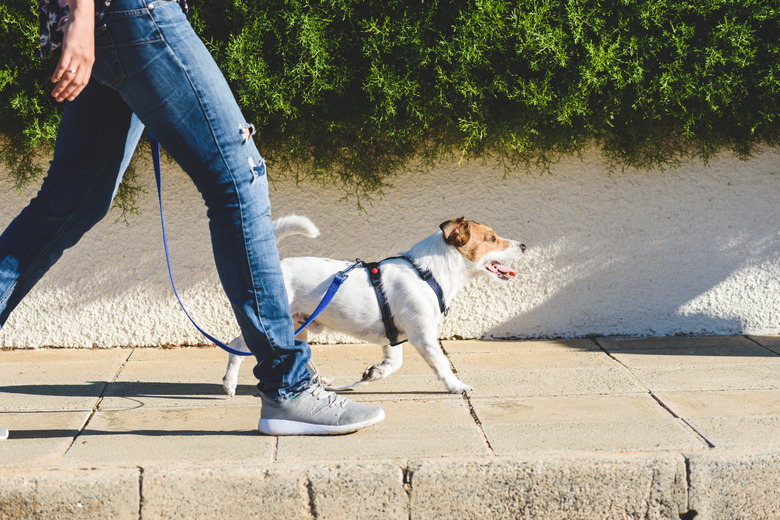Signs Your Dog Is Stressed (And What To Do About It)
In the modern world, it is easy for anyone to become overwhelmed. Stress and anxiety may have become commonplace in some of our daily lives. What you may not realize is how even normal stress like loud noises affects our canine companions. You may be asking yourself what the signs your dog is stressed are, and if you notice the signs of a stressed or anxious dog, what you should do about it.
What situations are stressful for dogs?
What situations are stressful for dogs?
There are many situations that can be causes of stress for a dog. Some of those things include:
- Small children and their erratic movements
- A change or disruption in a daily routine
- Heat — yes, heat can cause stress on a dog's mental and physical being
- Boredom or a lack of mental stimulation
- Previous trauma
- Being around another dog who is displaying aggressive behaviors
- New environments or people, crowded situations, too many strange people or animals
- Separation anxiety
- Very noisy situations, whether it is a living space, thunderstorms or fireworks
Signs of stress in dogs
Signs of stress in dogs
As humans, our main form of communication is through speech. However, as dog parents, it's essential to understand that our furry friends speak using their body language. Dogs employ their body posture to show humans when they are excited, scared, and overstimulated. Dogs express their stress through various signals that pet owners should learn to identify, including pacing or growling. By understanding these signals, dog owners can help to alleviate their dog's stress levels and prevent what could become a dangerous situation.
-
Growling: a common warning signal that is a way for them to let
you know they are uncomfortable, that they feel threatened, or that they are in
pain. -
Stiff body or freezing: a signal that your dog may be shutting down
from an overly stressful situation and that they can't handle it. -
Pacing
-
Different mouth behaviors like yawning, drooling, and lip licking
-
Excessive and unfocused barking: although barking is common,
barking in excess can be a sign of stress in a dog and can also signal other
issues such as separation anxiety. -
Showing the whites of the eyes: also known as whale eye
-
A dog's ears pinned back or rigid
-
Displacement behavior: sniffing the ground, turning away, circling,
licking themselves are all possible forms of escapism for a dog when they are
attempting to avoid a situation -
Excessive shedding: when anxiety levels rise in a dog, excessive shedding
may occur -
Panting
-
Tail tucking
-
Diarrhea or even constipation: a change in your dog's bodily functions, such as gas or
bloating, can also be side effects of extreme stress -
Decreased appetite
READ MORE: What is Your Dog's Body Language Telling You?
How stress affects a dog's health
How stress affects a dog's health
Stress in dogs, like in humans, stress can can cause harm to a dog's mental and physical wellbeing. Changes in a dog's health is common and can be indicators of stress. Excessive chewing may begin, not only with household objects, but dogs may also begin to chew on their own bodies. Inappropriate urination, defecation and gland expression or other destructive behavior such as constant licking is a common side effect of released stress hormones. Stress can also cause a weakened immune system within our dogs. For dogs with compromised immune systems, stress can exacerbate any pre-existing health issues.
How to help a stressed dog
How to help a stressed dog
There are many options available to dog parents who find that their companion is extremely anxious or stressed. From holistic means to medication, relief is possible for your dog. Some means of alleviation are:
- Environmental management: simply not exposing your dog to an environment is sometimes
the easiest preventative measure an owner can take - Thundershirts: similar to swaddling a baby, a tightly wrapped
coat can help a dog feel safe and secure in their environment - Herbal supplements: Some dog parents find that supplements containing melatonin or chamomile
are effective for dogs with anxiety. However, their efficacy has not been proven. - Music: A 2017 study showed that specific genres of music were
effective with calming dogs within a kennel environment. The most soothing
music was reggae and soft rock. - Creating a safe zone: utilizing your dog's crate or a creating a
quiet place within your home - CBD oil: this is another supplement which is not proven (and also not FDA-regulated), so proceed with caution. However, some dog parents report that it helps dogs with high anxiety.
- Anti-anxiety medication: speak with your veterinarian about
whether medication may be necessary for your dog's anxiety. - Exercise: regular exercise helps release
excess energy and tension. Walking, running or even just a game of fetch can be an inexpensive and effective outlet for your dog. - Tellington TTouch or similar touch therapies
- Training: speak with a certified trainer on how you can alleviate
behaviors that may be stress-inducing for your dog. - Confidence-building techniques: desensitization and
counterconditioning can help manage stressors a dog may face. Speak with a
certified behaviorist or dog trainer regarding proper techniques.
READ MORE: How Much Physical Activity Does a Dog Need Every Day?
Understanding your dog and their stress triggers is essential for prevention. Be sure to consult with your veterinarian if you notice any behavior change or there are drastic changes in your own living situation. Also, seek out a qualified animal behaviorist or dog trainer if necessary to keep your dog's behavior under control, so you both can go on to living a happy and healthy life.


